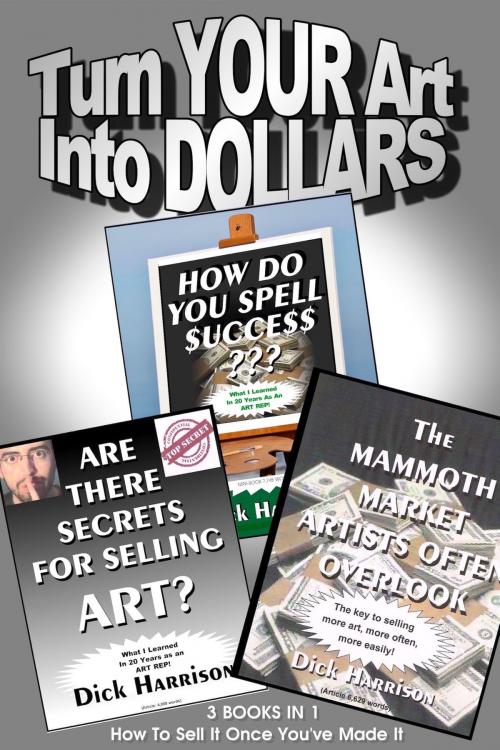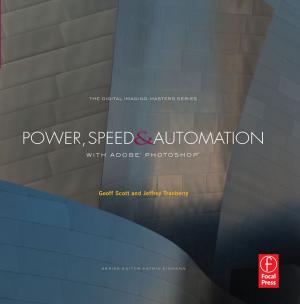Turn Your Art Into Dollars
Nonfiction, Art & Architecture, Photography, Equipment & Techniques, Techniques| Author: | Dick Harrison | ISBN: | 9781370844869 |
| Publisher: | Dick Harrison | Publication: | April 22, 2017 |
| Imprint: | Smashwords Edition | Language: | English |
| Author: | Dick Harrison |
| ISBN: | 9781370844869 |
| Publisher: | Dick Harrison |
| Publication: | April 22, 2017 |
| Imprint: | Smashwords Edition |
| Language: | English |
During the years I traveled throughout the state of Florida selling my own art, that of other artists and publishers of fine art prints, reproductions, and posters I met and sold work by artists in all stages of their careers. They were imaginative, hard working, creative people just like you.
Some were talented amateurs who never needed to make a buck from what they created. For them, a sale meant “fun” money. Others, like me, needed to turn time and talent into dollars to support themselves and their families. A number held full-time jobs and made art in whatever time was left over after earning a weekly paycheck. For a fortunate few, the other job was in the art field. For still others, the regular dollars came from some unrelated occupation they longed to chuck so they could create art full-time.
Over the years I watched, and helped, a number transition from part-timers to full-time “my art pays for everything” happy artists. That was a road I traveled to become a producing artist and artists' representative. If that's your goal, this book is definitely for you. But I believe it will help any artist no matter what part of the journey he or she may be on from “starting out” to “almost there.”
Podcasts of many of my articles, including many selections from Sales Tips For Artists are available on talkshoe.com (search Dick Harrison). Artists from more than 60 countries have listened, read and learned practical ways to increase the sales of art they have created. I've been fortunate in contributing guest blogs to Award Winning Art Marketing News and co-authored How to Sell Art to Interior Designers with Barney Davey.
Here's what is covered in How Do You Spell $ucce$$?: What's Important to You?, Take This Job and Shove It?, Full-time Artist – Are You Ready?, Knowing When is as Important as Knowing How, Knowing When “THE WHEN” Can happen, Don't Short Change Your Family and Friends, Unrealistic Expectations, Over Commitment – Under Performance, Skills That Will Help You Sell Yourself and Your Art, Sharpen Your Focus, Think Like a Salesman, Be Open to New Opportunities, Explore Niche Markets, Offer an Additional Service.
Here is some of what is covered in The Mammoth Market Artists Often Overlook: Four Categories of Art Buyers, It's Not Necessary to Have a Name to Sell, Finding Buyers, Setting Appointments to Show Your Work, What Should I Say?, The Importance of Color, Color Trends Change, Any Special Medium for My Art?, Produce What the Client Needs, Pricing Your Art, Price Affects How and What You Paint, The Pricing “Catch 22”, Regional Variations, To Frame or Not to Frame?
Here's what is covered in Are The Secrets For Selling Art: Why Most People Buy Art, The Importance of Color, When You Show It Makes a Difference, How to Enhance Your Sales, How to Identify Potential Customers, How to Present Yourself and Your Art, How to Network with Other Artists, How to Barter Your Art for Fun and Profit.
During the years I traveled throughout the state of Florida selling my own art, that of other artists and publishers of fine art prints, reproductions, and posters I met and sold work by artists in all stages of their careers. They were imaginative, hard working, creative people just like you.
Some were talented amateurs who never needed to make a buck from what they created. For them, a sale meant “fun” money. Others, like me, needed to turn time and talent into dollars to support themselves and their families. A number held full-time jobs and made art in whatever time was left over after earning a weekly paycheck. For a fortunate few, the other job was in the art field. For still others, the regular dollars came from some unrelated occupation they longed to chuck so they could create art full-time.
Over the years I watched, and helped, a number transition from part-timers to full-time “my art pays for everything” happy artists. That was a road I traveled to become a producing artist and artists' representative. If that's your goal, this book is definitely for you. But I believe it will help any artist no matter what part of the journey he or she may be on from “starting out” to “almost there.”
Podcasts of many of my articles, including many selections from Sales Tips For Artists are available on talkshoe.com (search Dick Harrison). Artists from more than 60 countries have listened, read and learned practical ways to increase the sales of art they have created. I've been fortunate in contributing guest blogs to Award Winning Art Marketing News and co-authored How to Sell Art to Interior Designers with Barney Davey.
Here's what is covered in How Do You Spell $ucce$$?: What's Important to You?, Take This Job and Shove It?, Full-time Artist – Are You Ready?, Knowing When is as Important as Knowing How, Knowing When “THE WHEN” Can happen, Don't Short Change Your Family and Friends, Unrealistic Expectations, Over Commitment – Under Performance, Skills That Will Help You Sell Yourself and Your Art, Sharpen Your Focus, Think Like a Salesman, Be Open to New Opportunities, Explore Niche Markets, Offer an Additional Service.
Here is some of what is covered in The Mammoth Market Artists Often Overlook: Four Categories of Art Buyers, It's Not Necessary to Have a Name to Sell, Finding Buyers, Setting Appointments to Show Your Work, What Should I Say?, The Importance of Color, Color Trends Change, Any Special Medium for My Art?, Produce What the Client Needs, Pricing Your Art, Price Affects How and What You Paint, The Pricing “Catch 22”, Regional Variations, To Frame or Not to Frame?
Here's what is covered in Are The Secrets For Selling Art: Why Most People Buy Art, The Importance of Color, When You Show It Makes a Difference, How to Enhance Your Sales, How to Identify Potential Customers, How to Present Yourself and Your Art, How to Network with Other Artists, How to Barter Your Art for Fun and Profit.















